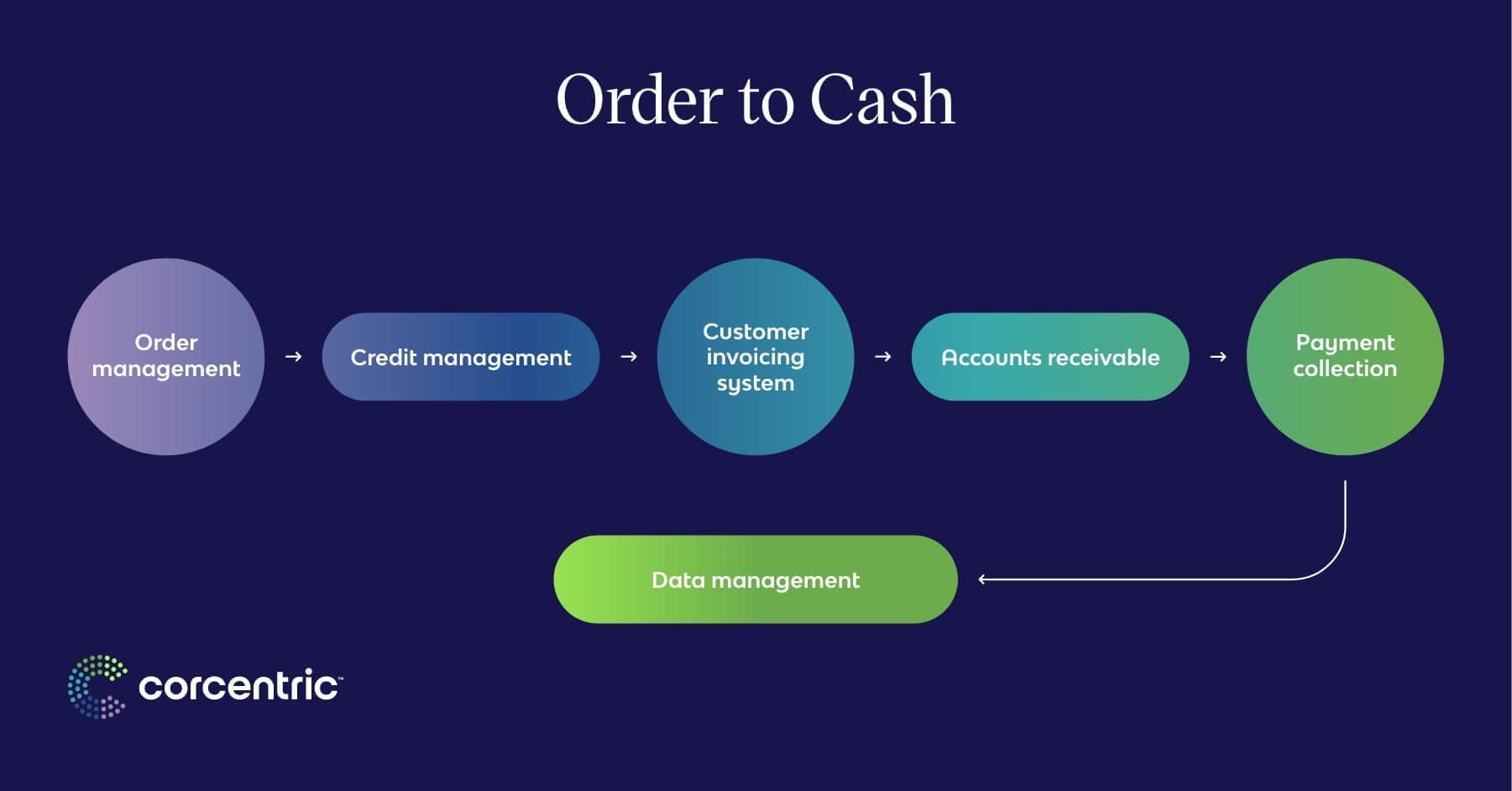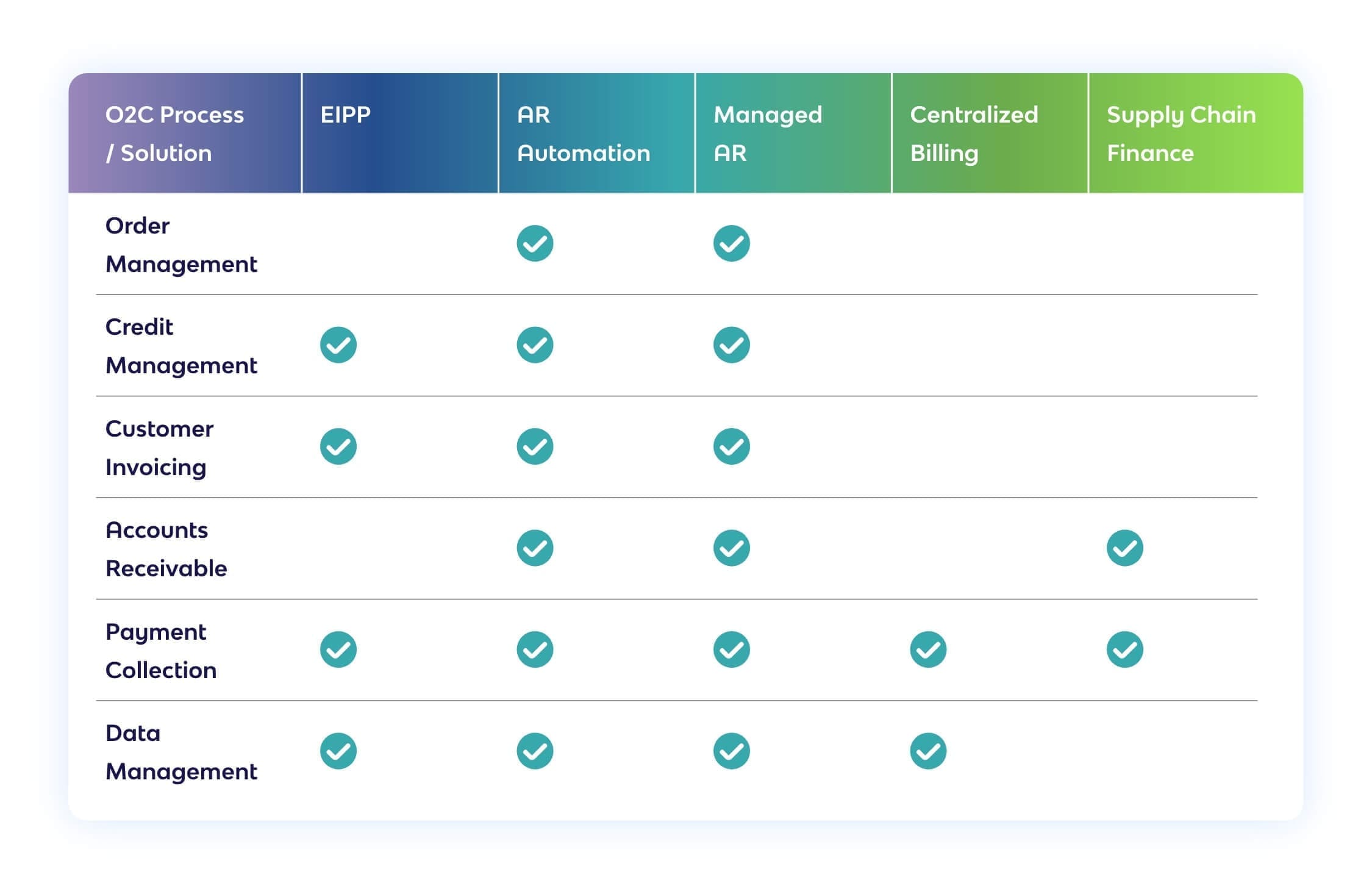Your comprehensive handbook on order-to-cash
Home - Your comprehensive handbook on order-to-cash
Corcentric

The order-to-cash process, often called O2C or OTC, is a critical component of any business, encompassing all stages from when a customer order is placed until the company has the cash in hand. It involves steps such as order management and fulfillment, credit management, invoicing, and ultimately payment collection.
The O2C process directly impacts an organization’s cash flow, with any inefficiencies resulting in increased days sales outstanding (DSO), meaning receivables are essentially trapped in the balance sheet. An optimized O2C results in an accelerated cash conversion cycle, allowing the organization more resources to carry out strategic initiatives that boost growth.
Let’s delve deeper into each step below:

Order management
O2C begins with an order, usually placed by a customer via various channels such as e-commerce platforms or direct sales order processes. The order processing system then checks inventory to confirm that the goods can be dispatched, and a delivery timeframe is issued. The customer’s credit facility is verified to determine if the order was accepted on existing credit terms before being recorded in the sales ledger. After the goods are shipped, automatic re-ordering via the enterprise resource planning (ERP) system is triggered for inventory replenishment.
Credit management
B2B sales are generally made on credit, allowing time for an invoice to be generated, sent, and paid while the fulfillment of each order carries on undisturbed. However, that credit is awarded based on an assessment of a buyer’s ability to pay. Credit should be determined early to prevent payment risks when invoices are due.
Customer invoicing system
Customers are invoiced for each order to request payment for goods purchased which must be paid within a specified timeframe. This process is greatly accelerated via customer invoicing systems that automatically generate and deliver customer invoices. Invoicing automation must handle a vast number of nuances and variables, including invoice format, delivery mechanism and media, recipient, approval process, associated documentation, and many other factors.
Invoice deliverability is vital to avoid delays caused by delivery blockers while having complete visibility of where your invoice is going.
Accounts receivable
The accounts receivable (AR) process occurs once a sale is made and the goods are shipped, comprising invoice generation and delivery, tracking, and reconciliation of payments against the ledger.
To minimize the time-consuming task of sending payment reminders or statements, savvy AR teams generally automate distribution before invoices are due. With automation removing arduous tasks like manual data key-in, the AR team can focus on activities that require human intervention, such as resolving incorrect invoice amounts and disputes.
Payment collection
The payment process should be made clear at the time of purchase and in the invoice (or accompanying documentation) to provide a smooth customer journey. Payment collection then happens through online payments, bank transfers, or payment submission in other formats. A purchase order number is typically used for tracking, ensuring each payment is correctly matched to its corresponding order. Outstanding invoices are chased directly until a predefined point, after which they are considered bad debt or passed to a third-party collections agency.
Data management
Good data management is vital when optimizing the O2C process. An organization’s order management system needs to connect to inventory management via an ERP system in real time to determine stock levels and fulfill orders or trigger reorders.
Invoicing systems should have a trigger that tells it to create an invoice when orders are fulfilled; the system will then pull in data about the order and check the customer’s credit limits and agreed on payment terms before generating and delivering the invoice.
The payment collections process then links back to the purchase ledger to ensure payments are reconciled against the correct order. To ensure optimum efficiency and accuracy, every step should be automated.
Benefits of O2C automation
The future of financial processes lies in automation, and most, if not all, organizations need to shift their mindsets to embrace digitization. The pandemic completely reworked the way companies operated, with a 2020 survey by McKinsey reporting that automation adoption rates are now years ahead of where they were pre-pandemic.
No longer is automation the solution to survive, but it is, in fact, the means with which to transform your organization. The benefits of O2C automation include increased revenue, improved operational efficiency, and enhanced customer experience.
Automating O2C processes yields direct and indirect benefits due to their inherent interlinkages. Here are three ways that O2C automation can propel your organization forward:
Improved efficiency and time-saving
Imagine an organization that utilized an O2C process heavily reliant on manual labor. The resources required to keep track of invoices, orders, and payments would be Sisyphean. That’s without taking into consideration the troubleshooting required when errors occur.
When a system like O2C is automated, it removes all the manual tasks, requiring minimal human intervention, freeing up resources and time, and allowing an organization’s staff to take on much more strategic ventures.
Enhanced cash flow and cost reduction
Working capital is instrumental to an organization’s growth. Inefficient O2C processes hinder your cash conversion cycle (CCC) considerably, decreasing the resources you have readily available to you. Automation accelerates workflows such as credit management and invoicing, significantly shortening the CCC, freeing up cash that can be used for organizational growth.
On top of that, automation means significantly reduced operational costs through better resource optimization, lowered labor costs, enhanced financial visibility, better scalability, and many more aspects.
Improved accuracy and stakeholder experience
Heavily relying on manual labor for tasks such as data entry, verification, and order processing, inevitably leads to higher human error rates, especially when handling high order volumes. Cases like this will impact the relationships you have with both your customers and suppliers.
With automation, accuracy is significantly increased across all workflows; your customers enjoy faster order processing and accurate order fulfillment, greater visibility of their orders, prompt and accurate invoicing, and ease of payment. Implementing online payment platforms that offer more payment options streamlines the process further.
How automation works in the O2C context
Without understanding how automation fits into O2C and knowing precisely what your organization needs, automation becomes little more than a buzzword.
First off, give some thought to where your organization stands by asking these questions:
o What are your pre-established O2C processes?
A clear vision of your O2C route lets you understand exactly what you need to automate for the most beneficial results.
o If you’re already trying to automate, what challenges are you facing?
Not all solutions are created equal, and a bad match could create more problems than what’s already on your plate.
o Are your invoices digitized?
This question may sound obvious, but some business owners are still reluctant to let go of analog processes, so asking this gives you a clear point to start.
o What does your data say?
By extracting existing O2C data, you can identify gaps such as redundant processes, repeated customer complaints, and points where payment is hindered.
Once you understand where your organization stands, you need to know what to look for in automation. O2C technology needs to be agile, adaptable, scalable, and able to integrate with your existing ERP system. Many of the automation tools overlap across the O2C process, so it’s important to know what works for your organization.
Here we look into how automation complements each stage of O2C:
Start of the O2C process
Order management is the first step of O2C, benefiting greatly from automation. Rather than orders being delayed by inaccurate information and cash flow bogged down by frequent discrepancies, the standardized forms and templates provided by the solution ensure smooth management of any number of orders. Automated validation rules also instantly recognize errors, significantly reducing the risk of incorrect orders.
Gone are the days of resource-intensive credit management. With the implementation of e-invoicing, every invoice, statement, and payment record is readily available for verification. Credit management automation also saves time by removing the manual tasks of copy-and-pasting contact details or repetitive printing, stuffing, sealing, and franking of posted invoices.
Middle of the O2C process
Manual processes and workflows greatly hinder the delivery of customer invoices, with invoices needing to be routed to different individuals or groups depending on what was purchased, how much was purchased, and where it was purchased. Chasing payments also takes up valuable time that could be used on company growth, and a lack of in-depth analytics means an inability to accurately forecast cash flow which risks your liquidity.
Using solutions such as Electronic Invoice Presentment and Payment (EIPP) or AR automation that can be directly integrated into your ERP system, you automate exactly what needs to be automated, with human involvement reserved for oversight, exception handling, and decision-making. Even the error-prone task of uploading invoices to customer portals can be automated, letting your AR team focus on more value-adding work. It is not just time and labor you save; by choosing solutions like EIPP over methods like email, you reduce risks by providing a platform with security that is equivalent to online banking.
Ensuring your AR process is continuously optimized is key to ensuring smooth cash flow for your organization. An AR flow hindered by manual processes means trapped working capital you cannot utilize as payment cycles are slowed by late invoice delivery. Without automation, your AR team is stuck doing tasks like manual data entry and invoice payment reminders instead of handling more essential activities like managing exceptions.
AR automation smoothens the workflow, taking those labor-intensive tasks out of employees’ hands so they can focus on work that matters, leading to greater efficiency, time-saving, and accuracy. Faster payment processing means better cash flow management, with automated AR systems providing full visibility via data-driven reports that aid decision-making and financial analysis.
Managed AR takes all this one step further with the ability to fix your DSO to a specific number of days through funding, where you get paid within your desired DSO window while your customer is offered a longer payment term.
End of the O2C process
An unclear payment collection process can hamper your receivables flow and impact customer experience. To ensure smooth payment, invoices must first be sent out on time and with accurate information. Customers should then be offered a platform that accommodates a variety of payment options such as ACH, Virtual Card, Check, and Pre-Paid Card. All this can be achieved with an EIPP solution, which also contributes to a paperless work environment, with the decision to print the receipt lying with the customer.
To ensure continuous optimization of an O2C cycle, data management is vital. The ability to view gaps and areas of improvement throughout the process is the gateway to much-improved cash flow. Automating the entire process provides in-depth insights at the touch of a button rather than getting lost in paper trails. Leveraging O2C analytics software automates data collection and analysis, empowering decision-makers with the visibility needed to make well-informed decisions that benefit the organization holistically.
Here is a brief breakdown of solutions that complement different O2C stages:

The case for Corcentric vs. the rest
Digital transformation is clearly on the rise. With it soon becoming the norm, there are myriad options to choose from when it comes to automating your business. However, in a slew of choices, how do you pick the best one for your organization? When it comes down to it, it isn’t about who does it best but who fits you the most.
Here is a comparison between Corcentric and traditional O2C solutions:
Technology
AR technology offers a wide range of toolsets that enhance efficiency across the O2C cycle. These ever-evolving technologies collect and analyze receivables data, providing insight into customer behavior to better mitigate risks. However, the integration of this tech into existing O2C workflows remains a barrier, with questions of ROI and the protracted time it takes to yield results inevitably arising. While it provides visibility and risk mitigation, AR automation alone cannot ensure significant DSO impact or complete elimination of credit risk.
BPO
Business process outsourcing (BPO) is chosen when an organization recognizes they lack resources in technology, staffing, or expertise within its O2C function, with BPO leading to labor cost savings for tasks such as invoice distribution and collections. While BPOs offer industry-specific knowledge and access to advanced O2C technology, they also require considerable up-front expenses when implementing their technologies into your O2C cycle. On top of that, their fee structure does not incentivize the highest quality of service, and they lack financial management services that address credit risk, payment management, and guaranteed DSO decrease.
Financial services
Financial services are a popular traditional O2C option as they can eliminate credit risks for the company by assuming a financial role in customer transactions. This category typically comprises traditional banks or lending institutions, factoring companies, and seller-led supply chain finance providers. While they offer services such as selectively unlocking cash from outstanding receivables or extending credit, their stringent credit qualifications limit a supplier’s customer base. They also charge high fees, and considerable time is required to integrate a seller’s ERP or invoicing systems into their own.
How is Corcentric different?
Corcentric’s managed O2C solution provides a holistic approach that combines all the benefits of the three traditional O2C solutions above in a cost-effective manner by providing the tools, talent, and ability to guarantee payments, we can eliminate credit risk and provide DSO reduction. Our solutions can also be tailor-made to fit your organization’s exact requirements.
With in-depth knowledge and subject matter expertise in the procurement and supply chain industries, Corcentric’s AP and AR solutions cover a variety of industries. Handling all O2C activities from customer onboarding and credit qualification to invoice delivery and dispute management, the managed aspect also liberates full-time equivalents (FTE), allowing staffing expense savings or redeployment into more strategic initiatives.
Case study: How this organization benefited from Corcentric’s O2C solutions
Baird & Warner
The Challenge
Tasked with creating a paper-free work environment, Baird & Warner’s AP department needed to convert more than 18,000 non-PO paper invoices annually into e-invoices without causing any disruption. Orders coming in from each corporate location were not visible to the centralized AP department, often arriving after the books were closed. The organization needed a solution to solve the paper issue, enable accurate month-end accrual reporting, and provide the opportunity to grow the business without adding personnel.
The Solution
Cor360 Approval Workflow
Corcentric’s Cor360 Approval Workflow solution includes invoice conversion and data capture at Corcentric’s Invoice Virtualization Center, e-invoicing, supplier network, approval workflow automation, and e-payments. Baird & Warner personnel were given training and, within six weeks, were already comfortable with the product.
The Results
Baird & Warner achieved their management’s paper-free mandate, reducing invoice payments with paper checks by almost 40%. The solution’s scalability also enables the company to handle a 50 to 75% increase in business with existing staff. The AP department has full visibility of invoices statuses allowing for timely payments and improved cash flow. With the increased productivity, many of their administrative staff can focus on generating revenue by aiding real estate agents.
For more case studies, visit https://www.corcentric.com/case-studies/
O2C automation—a key starting point to organizational transformation
O2C is an inevitable part of every business, with each business doing it differently. Ultimately, while the means may differ, the desired outcomes are the same—minimized credit risks, simplified the cash cycle, and improved working capital to grow the business.
Corcentric has spent decades helping businesses flourish by taking the nitty gritty out of your workflows and transforming them into significant improvements in performance. Offering flexibility and scalability while tailoring our solutions to your needs, we empower your O2C cycle with data-driven insights that drive up efficiency and productivity that, most importantly, will positively impact cash flow and customer satisfaction.
Speak to our O2C experts to understand how we can aid your transformation into embracing automation solutions that elevate your organizational operations.TALK TO OUR EXPERTS